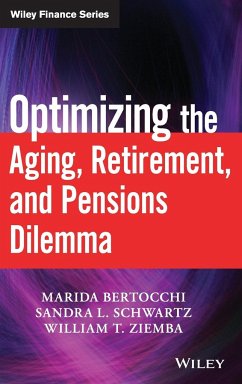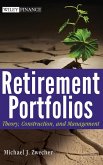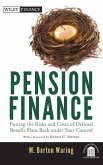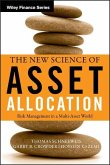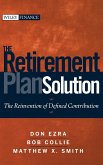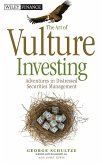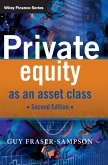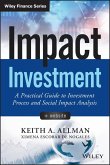Marida Bertocchi, Sandra L. Schwartz, William T. Ziemba
Optimizing the Aging, Retirement, and Pensions Dilemma
Marida Bertocchi, Sandra L. Schwartz, William T. Ziemba
Optimizing the Aging, Retirement, and Pensions Dilemma
- Gebundenes Buch
- Merkliste
- Auf die Merkliste
- Bewerten Bewerten
- Teilen
- Produkt teilen
- Produkterinnerung
- Produkterinnerung
A straightforward guide focused on life cycle investing-namely aging, retirement, and pensions
Life cycle investing and the implications of aging, retirement, and pensions continues to grow in importance. With people living longer, the relative and absolute number of retirees is growing while the number of workers contributing to pension funds is declining.
This reliable resource develops a detailed economic analysis-at the micro (individual) and macro (economy wide) levels-which addresses issues regarding the economics of an aging population. Topics touched upon include retirement and…mehr
Andere Kunden interessierten sich auch für
![Retirement Portfolios Retirement Portfolios]() Michael J. ZwecherRetirement Portfolios69,99 €
Michael J. ZwecherRetirement Portfolios69,99 €![Pension Finance Pension Finance]() M. Barton WaringPension Finance81,99 €
M. Barton WaringPension Finance81,99 €![The New Science of Asset Allocation The New Science of Asset Allocation]() Thomas SchneeweisThe New Science of Asset Allocation69,99 €
Thomas SchneeweisThe New Science of Asset Allocation69,99 €![The Retirement Plan Solution The Retirement Plan Solution]() Don EzraThe Retirement Plan Solution79,99 €
Don EzraThe Retirement Plan Solution79,99 €![The Art of Vulture Investing The Art of Vulture Investing]() George SchultzeThe Art of Vulture Investing69,99 €
George SchultzeThe Art of Vulture Investing69,99 €![Private Equity as an Asset Class Private Equity as an Asset Class]() Guy Fraser-SampsonPrivate Equity as an Asset Class74,99 €
Guy Fraser-SampsonPrivate Equity as an Asset Class74,99 €![Impact Investment, + Website Impact Investment, + Website]() Keith A. AllmanImpact Investment, + Website103,99 €
Keith A. AllmanImpact Investment, + Website103,99 €-
-
-
A straightforward guide focused on life cycle investing-namely aging, retirement, and pensions
Life cycle investing and the implications of aging, retirement, and pensions continues to grow in importance. With people living longer, the relative and absolute number of retirees is growing while the number of workers contributing to pension funds is declining.
This reliable resource develops a detailed economic analysis-at the micro (individual) and macro (economy wide) levels-which addresses issues regarding the economics of an aging population. Topics touched upon include retirement and the associated health care funding of the aged as well as social security and the asset classes that are considered asset-liability choices over time.
The probability of achieving adequate return patterns from various investment strategies and asset classes is reviewed
Shares rich insights on the aging, retirement, and pensions dilemma
An assessment of the resources the real economy will be able to commit to non-workers is provided
The three pillars of retirement are social security, company pensions, and private savings. Each of these pillars is confronted with a variety of asset-liability problems, and this book will addresses them.
Hinweis: Dieser Artikel kann nur an eine deutsche Lieferadresse ausgeliefert werden.
Life cycle investing and the implications of aging, retirement, and pensions continues to grow in importance. With people living longer, the relative and absolute number of retirees is growing while the number of workers contributing to pension funds is declining.
This reliable resource develops a detailed economic analysis-at the micro (individual) and macro (economy wide) levels-which addresses issues regarding the economics of an aging population. Topics touched upon include retirement and the associated health care funding of the aged as well as social security and the asset classes that are considered asset-liability choices over time.
The probability of achieving adequate return patterns from various investment strategies and asset classes is reviewed
Shares rich insights on the aging, retirement, and pensions dilemma
An assessment of the resources the real economy will be able to commit to non-workers is provided
The three pillars of retirement are social security, company pensions, and private savings. Each of these pillars is confronted with a variety of asset-liability problems, and this book will addresses them.
Hinweis: Dieser Artikel kann nur an eine deutsche Lieferadresse ausgeliefert werden.
Produktdetails
- Produktdetails
- Wiley Finance Series
- Verlag: Wiley & Sons
- 1. Auflage
- Seitenzahl: 432
- Erscheinungstermin: 8. Februar 2010
- Englisch
- Abmessung: 235mm x 157mm x 28mm
- Gewicht: 772g
- ISBN-13: 9780470377345
- ISBN-10: 0470377348
- Artikelnr.: 27065303
- Herstellerkennzeichnung
- Libri GmbH
- Europaallee 1
- 36244 Bad Hersfeld
- gpsr@libri.de
- Wiley Finance Series
- Verlag: Wiley & Sons
- 1. Auflage
- Seitenzahl: 432
- Erscheinungstermin: 8. Februar 2010
- Englisch
- Abmessung: 235mm x 157mm x 28mm
- Gewicht: 772g
- ISBN-13: 9780470377345
- ISBN-10: 0470377348
- Artikelnr.: 27065303
- Herstellerkennzeichnung
- Libri GmbH
- Europaallee 1
- 36244 Bad Hersfeld
- gpsr@libri.de
MARIDA BERTOCCHI is Professor of Portfolio Theory, University of Bergamo. She taught numerous courses at the Universities of Bergamo, Urbino and Milan, including basic and advanced calculus, mathematical finance, advanced mathematical finance, stochastic optimization, and parallel processing. Bertocchi has been Dean of the Faculty of Economics and Business Administration and is the Director of the Department of Mathematics, Statistics, Computer Science and Applications, University of Bergamo. She is the author of numerous publications on bond portfolio management, asset allocation, quantitative finance, and economic and financial applications. SANDRA L. SCHWARTZ received her interdisciplinary PhD from the University of British Columbia in commerce, economics, and ecology. She has taught business policy, business and society, and topics in research and development and applied economics at Berkeley, UCLA, Tsukuba, UBC, and Simon Fraser. Schwartz designed programs and courses for the Open University of BC. She is the author of a number of books on energy policy, Japanese management and economy, and other topics, as well as numerous articles. WILLIAM T. ZIEMBA is the Alumni Professor of Financial Modeling and Stochastic Optimization (Emeritus), University of British Columbia. He is a well-known academic with books, research articles, and talks on various investment topics and a columnist for Wilmott magazine. Ziemba has visited and lectured at MIT, University of Chicago, Berkeley, UCLA, Cambridge, LSE, Oxford, and the ICMA Centre. He trades through William T. Ziemba Investment Management Inc. He has consulted for various financial institutions including hedge funds, pension, and other investment institutions.
Acknowledgments xv
Preface xvii
Part One The Aging Population: Issues for Retirement 1
Chapter 1 Issues in Retirement 3
1.1 Longevity and Changing Demographics across the World 4
1.2 The Evolution of Retirement 8
1.2.1 Older Workers as a Growing Share of the Work Force 11
1.3 Provision for Retirement 11
1.3.1 The Earliest Pensions 11
1.3.2 Early Corporate Pensions 12
1.3.3 Total Assets on Retirement 15
1.3.4 The Contribution of Various Assets at Retirement 15
References 19
Chapter 2 The Various Costs of Pensions: Macro and Micro 21
2.1 Governmental Cost of Retirement 21
2.2 Pensions and Capital Formation 22
2.3 Regulating Corporate Pensions 24
2.3.1 US Regulations 24
2.3.2 Corporate Bankruptcies Leave a Trail of Broken Promises 30
2.3.3 Comparing Regulation of Occupational Pension Schemes in the EU and
the United States 31
2.4 DC vs. DB: Shifting the Risks 33
2.4.1 Pensions, Corporate Earnings, and Tax Deferral 37
2.5 Freezing Pension Plans 39
2.6 Where Do We Go from Here? 40
References 41
Chapter 3 The Various Pillars of Retirement: Social Security, Company
Pensions, Supplementary Pensions, and Private Savings 43
3.1 Pillars of Retirement 43
3.2 Reforming OECD Pensions 51
3.3 Changing Role of Private Pensions 51
3.3.1 Summarizing Pension Reforms in the OECD 55
3.4 Plans for Reforming Social Pensions 56
3.4.1 Increase Contributions, Cut Benefits, Extend Working Life 56
3.4.2 Use the Contributions to Buy Stocks instead of Government Bonds 58
3.5 Rethinking Pension Promises: Breaking the Fixed Link to a Monetary
Value 61
3.5.1 Feldstein's PRA with Guarantees 61
3.5.2 NDC: Notational or Nonfinancial Defined Contributions 62
3.5.3 The PAAW (Personal Annuitized Average Wage Security), a Variant of
the NDC 66
3.6 Intergenerational Risk-Sharing 67
3.7 Conclusions 69
3.8 Case Study: Public Sector vs. Private Pensions 70
3.8.1 Government Plans Are Different: US 70
3.8.2 Government Plans Are Different: Canada 72
3.8.3 What Do We Learn from These Comparisons? 73
References 73
Chapter 4 Asset Classes: Historical Performance and Risk 77
4.1 Equities 77
4.2 ETFs: Exchange-Traded Funds 89
4.2.1 Levered ETFs 93
4.3 Bonds and Fixed Income 93
4.3.1 TIPS 95
4.4 The Bond-Stock Measure for Medium-Term Large Crash Prediction 95
4.4.1 The 2000-2003 Crash in the S&P 500 103
4.5 Hedge Funds 112
4.6 Real Assets 121
4.6.1 REITs 121
4.7 Housing as an Asset Class 121
4.8 Gold and Other Commodities 125
4.9 Private Equity and Related Assets 126
4.10 Currencies 126
4.11 Evaluation of Great Investors 129
4.12 Fundamental and Seasonal Anomalies of Asset Returns 135
References 141
Chapter 5 The Current Economic Crisis and Its Impact on Retirement
Decisions 145
5.1 Household and Government Debt 145
5.2 Were the Crash Models Helpful in Signaling the US and Worldwide
2007-2009 Crash? 146
5.3 The Subprime Crisis and How It Evolved 148
5.3.1 Favoring the Financial Sector: Evaluating the Policy Responses 150
5.4 Impact on Retirement Expectations 153
5.4.1 Plan Sponsors in Trouble 156
5.5 Pensions in Trouble 160
5.6 State Pensions 161
5.7 Future ERP 162
5.7.1 Companies Freezing Pension Plans 165
5.7.2 The Ultimate Strategy: Bankruptcy 165
5.8 Future Inflation and Pensions 165
References 166
Part Two Special Issues and Models 169
Chapter 6 The Impact of Population Aging on Household Portfolios and Asset
Returns 171
6.1 Introduction 171
6.2 The Empirical Evidence 172
6.2.1 The Empirical Evidence in a Micro-Perspective 173
6.2.2 The Empirical Evidence in a Macro-Perspective 181
6.3 Models for Portfolio Choices and Life-Cycle Asset Allocations 193
6.3.1 The Seminal Models 194
6.3.2 More Realistic Portfolio Models 196
6.3.3 Life-Cycle Asset Allocation Models with Uninsurable Labor Risk 198
6.3.4 Life-Cycle Asset Allocation Models in the Presence of Annuities 204
6.4 Conclusions 207
References 210
Chapter 7 A Continuous Time Approach to Asset-Liability Surplus Management
217
7.1 The Rudolf-Ziemba (2004) Intergenerational Surplus Management Model 218
7.2 A Case Study Application of the Rudolf-Ziemba Model 222
References 226
Chapter 8 Should Defined Benefit Pension Schemes Be Career Average or Final
Salary? 227
8.1 Introduction 227
8.2 Career Average Defined Benefit Schemes 228
8.3 Cost Neutrality 229
8.4 Choosing the Revaluation Rate 230
8.5 The Adoption of Career Average Pension Schemes 232
8.6 Advantages of a Switch to a Career Average Scheme 236
8.6.1 Employer 236
8.6.2 Members 240
8.7 Disadvantages of a Switch to a Career Average Scheme 241
8.7.1 Employer 241
8.7.2 Members 245
8.8 Redistribution Effects of a Switch to Career Average Pensions 245
8.8.1 Compensatory Salary Changes, Pension Contributions, NIC, and Income
Tax 247
8.8.2 Model of the Redistributive Effects of a Switch to Career Average 248
8.8.3 Numerical Example of the Redistributive Effects of a Switch to Career
Average 250
8.9 Conclusions 253
References 254
Chapter 9 Applying Stochastic Programming to the US Defined Benefit Pension
System 259
9.1 Introduction 260
9.2 Integrated Corporate/Pension Planning Model 261
9.2.1 Multiperiod Stochastic Programming Model 262
9.2.2 Alternative Goals 264
9.3 Assisting the Defined Benefit Pension System 265
9.3.1 Industry Projections 265
9.3.2 Applying Stochastic Programs to Industries in Trouble 270
9.4 Conclusions 273
References 274
Chapter 10 Mortality-Linked Securities and Derivatives 275
10.1 Introduction 275
10.2 Longevity Risk Transfers 278
10.2.1 Pension Buy-Outs 279
10.2.2 Securitization of Life Insurance Assets and Liabilities 281
10.3 Capital Market Solutions and the Development of Mortality-Linked
Securities and Derivatives 282
10.3.1 The EIB Longevity Bond 283
10.3.2 Mortality Catastrophe Bonds 284
10.4 Recent Trends in Mortality-Linked Securities 286
10.4.1 Mortality Indexes 286
10.4.2 Mortality Swaps and Forwards 287
10.4.3 Mortality/Longevity Futures and Options 289
10.5 Hedging Pension Liabilities with Mortality-Linked Securities and
Derivatives 290
10.5.1 Cash Flow Hedge Paradigm 290
10.5.2 Value Hedge Paradigm 291
10.5.3 Longevity Risk Pricing and Optimal Security Design 292
10.6 Conclusion 296
References 296
Chapter 11 Asset Allocation and Governance Issues of Government-Owned
Pensions 299
11.1 Introduction 299
11.2 Types of Sovereign Funds 301
11.3 Is There a Common Asset Allocation for Pension Funds? 303
11.4 Sovereign Pension Funds and International Capital Markets 305
11.5 Governance Issues of Public Pension Funds 306
11.5.1 Intergenerational Borrowing 306
11.6 Regional Trends 309
11.7 Conclusion 313
References 314
Chapter 12 Issues in Individual Asset-Liability Management for Retirement
315
12.1 Own Company Stock 315
12.2 The Role of Annuities 319
12.3 The Role of Insurance 321
12.4 The Role of Managed Withdrawal Plans 322
12.4.1 Mandatory Withdrawals 322
12.5 Where and How to Retire? 322
12.5.1 New Type Retirement Communities 323
12.5.2 Assisted Living 323
12.5.3 Reverse Mortgages 323
12.5.4 Does It Pay to Have Multiple Residences? 324
12.5.5 Interest-Free Loan 326
References 326
Part Three Modeling the Issues 329
Chapter 13 Learning from Other Models 331
13.1 Preserving Endowment Spending 331
13.1.1 Cloning the Yale Approach 335
13.1.2 Dealing with Liquidity the Yale Way 336
13.1.3 Swensen's Rule and Others 336
13.2 Devising a Rule So That Spending Never Falls 337
13.2.1 A Protective Spending Model 341
References 343
Chapter 14 The Innovest Austrian Pension Fund Financial Planning Model 345
14.1 How Should Companies Fund Their Liabilities and Determine Allocations
among Asset Classes and Hedging Instruments? 345
14.2 Formulating InnoALM as a Multistage Stochastic Linear Programming
Model 349
14.3 Some Typical Applications 352
14.4 Some Test Results 356
14.5 Model Tests 359
14.5.1 Final Comments 362
References 364
Chapter 15 An Individual ALM Model for Lifetime Asset-Liability Management
365
References 371
Chapter 16 Implementation and Numerical Results of Individual ALM Model for
Lifetime Asset-Liability Management 375
References 392
Chapter 17 Conclusions 393
Index 397
Preface xvii
Part One The Aging Population: Issues for Retirement 1
Chapter 1 Issues in Retirement 3
1.1 Longevity and Changing Demographics across the World 4
1.2 The Evolution of Retirement 8
1.2.1 Older Workers as a Growing Share of the Work Force 11
1.3 Provision for Retirement 11
1.3.1 The Earliest Pensions 11
1.3.2 Early Corporate Pensions 12
1.3.3 Total Assets on Retirement 15
1.3.4 The Contribution of Various Assets at Retirement 15
References 19
Chapter 2 The Various Costs of Pensions: Macro and Micro 21
2.1 Governmental Cost of Retirement 21
2.2 Pensions and Capital Formation 22
2.3 Regulating Corporate Pensions 24
2.3.1 US Regulations 24
2.3.2 Corporate Bankruptcies Leave a Trail of Broken Promises 30
2.3.3 Comparing Regulation of Occupational Pension Schemes in the EU and
the United States 31
2.4 DC vs. DB: Shifting the Risks 33
2.4.1 Pensions, Corporate Earnings, and Tax Deferral 37
2.5 Freezing Pension Plans 39
2.6 Where Do We Go from Here? 40
References 41
Chapter 3 The Various Pillars of Retirement: Social Security, Company
Pensions, Supplementary Pensions, and Private Savings 43
3.1 Pillars of Retirement 43
3.2 Reforming OECD Pensions 51
3.3 Changing Role of Private Pensions 51
3.3.1 Summarizing Pension Reforms in the OECD 55
3.4 Plans for Reforming Social Pensions 56
3.4.1 Increase Contributions, Cut Benefits, Extend Working Life 56
3.4.2 Use the Contributions to Buy Stocks instead of Government Bonds 58
3.5 Rethinking Pension Promises: Breaking the Fixed Link to a Monetary
Value 61
3.5.1 Feldstein's PRA with Guarantees 61
3.5.2 NDC: Notational or Nonfinancial Defined Contributions 62
3.5.3 The PAAW (Personal Annuitized Average Wage Security), a Variant of
the NDC 66
3.6 Intergenerational Risk-Sharing 67
3.7 Conclusions 69
3.8 Case Study: Public Sector vs. Private Pensions 70
3.8.1 Government Plans Are Different: US 70
3.8.2 Government Plans Are Different: Canada 72
3.8.3 What Do We Learn from These Comparisons? 73
References 73
Chapter 4 Asset Classes: Historical Performance and Risk 77
4.1 Equities 77
4.2 ETFs: Exchange-Traded Funds 89
4.2.1 Levered ETFs 93
4.3 Bonds and Fixed Income 93
4.3.1 TIPS 95
4.4 The Bond-Stock Measure for Medium-Term Large Crash Prediction 95
4.4.1 The 2000-2003 Crash in the S&P 500 103
4.5 Hedge Funds 112
4.6 Real Assets 121
4.6.1 REITs 121
4.7 Housing as an Asset Class 121
4.8 Gold and Other Commodities 125
4.9 Private Equity and Related Assets 126
4.10 Currencies 126
4.11 Evaluation of Great Investors 129
4.12 Fundamental and Seasonal Anomalies of Asset Returns 135
References 141
Chapter 5 The Current Economic Crisis and Its Impact on Retirement
Decisions 145
5.1 Household and Government Debt 145
5.2 Were the Crash Models Helpful in Signaling the US and Worldwide
2007-2009 Crash? 146
5.3 The Subprime Crisis and How It Evolved 148
5.3.1 Favoring the Financial Sector: Evaluating the Policy Responses 150
5.4 Impact on Retirement Expectations 153
5.4.1 Plan Sponsors in Trouble 156
5.5 Pensions in Trouble 160
5.6 State Pensions 161
5.7 Future ERP 162
5.7.1 Companies Freezing Pension Plans 165
5.7.2 The Ultimate Strategy: Bankruptcy 165
5.8 Future Inflation and Pensions 165
References 166
Part Two Special Issues and Models 169
Chapter 6 The Impact of Population Aging on Household Portfolios and Asset
Returns 171
6.1 Introduction 171
6.2 The Empirical Evidence 172
6.2.1 The Empirical Evidence in a Micro-Perspective 173
6.2.2 The Empirical Evidence in a Macro-Perspective 181
6.3 Models for Portfolio Choices and Life-Cycle Asset Allocations 193
6.3.1 The Seminal Models 194
6.3.2 More Realistic Portfolio Models 196
6.3.3 Life-Cycle Asset Allocation Models with Uninsurable Labor Risk 198
6.3.4 Life-Cycle Asset Allocation Models in the Presence of Annuities 204
6.4 Conclusions 207
References 210
Chapter 7 A Continuous Time Approach to Asset-Liability Surplus Management
217
7.1 The Rudolf-Ziemba (2004) Intergenerational Surplus Management Model 218
7.2 A Case Study Application of the Rudolf-Ziemba Model 222
References 226
Chapter 8 Should Defined Benefit Pension Schemes Be Career Average or Final
Salary? 227
8.1 Introduction 227
8.2 Career Average Defined Benefit Schemes 228
8.3 Cost Neutrality 229
8.4 Choosing the Revaluation Rate 230
8.5 The Adoption of Career Average Pension Schemes 232
8.6 Advantages of a Switch to a Career Average Scheme 236
8.6.1 Employer 236
8.6.2 Members 240
8.7 Disadvantages of a Switch to a Career Average Scheme 241
8.7.1 Employer 241
8.7.2 Members 245
8.8 Redistribution Effects of a Switch to Career Average Pensions 245
8.8.1 Compensatory Salary Changes, Pension Contributions, NIC, and Income
Tax 247
8.8.2 Model of the Redistributive Effects of a Switch to Career Average 248
8.8.3 Numerical Example of the Redistributive Effects of a Switch to Career
Average 250
8.9 Conclusions 253
References 254
Chapter 9 Applying Stochastic Programming to the US Defined Benefit Pension
System 259
9.1 Introduction 260
9.2 Integrated Corporate/Pension Planning Model 261
9.2.1 Multiperiod Stochastic Programming Model 262
9.2.2 Alternative Goals 264
9.3 Assisting the Defined Benefit Pension System 265
9.3.1 Industry Projections 265
9.3.2 Applying Stochastic Programs to Industries in Trouble 270
9.4 Conclusions 273
References 274
Chapter 10 Mortality-Linked Securities and Derivatives 275
10.1 Introduction 275
10.2 Longevity Risk Transfers 278
10.2.1 Pension Buy-Outs 279
10.2.2 Securitization of Life Insurance Assets and Liabilities 281
10.3 Capital Market Solutions and the Development of Mortality-Linked
Securities and Derivatives 282
10.3.1 The EIB Longevity Bond 283
10.3.2 Mortality Catastrophe Bonds 284
10.4 Recent Trends in Mortality-Linked Securities 286
10.4.1 Mortality Indexes 286
10.4.2 Mortality Swaps and Forwards 287
10.4.3 Mortality/Longevity Futures and Options 289
10.5 Hedging Pension Liabilities with Mortality-Linked Securities and
Derivatives 290
10.5.1 Cash Flow Hedge Paradigm 290
10.5.2 Value Hedge Paradigm 291
10.5.3 Longevity Risk Pricing and Optimal Security Design 292
10.6 Conclusion 296
References 296
Chapter 11 Asset Allocation and Governance Issues of Government-Owned
Pensions 299
11.1 Introduction 299
11.2 Types of Sovereign Funds 301
11.3 Is There a Common Asset Allocation for Pension Funds? 303
11.4 Sovereign Pension Funds and International Capital Markets 305
11.5 Governance Issues of Public Pension Funds 306
11.5.1 Intergenerational Borrowing 306
11.6 Regional Trends 309
11.7 Conclusion 313
References 314
Chapter 12 Issues in Individual Asset-Liability Management for Retirement
315
12.1 Own Company Stock 315
12.2 The Role of Annuities 319
12.3 The Role of Insurance 321
12.4 The Role of Managed Withdrawal Plans 322
12.4.1 Mandatory Withdrawals 322
12.5 Where and How to Retire? 322
12.5.1 New Type Retirement Communities 323
12.5.2 Assisted Living 323
12.5.3 Reverse Mortgages 323
12.5.4 Does It Pay to Have Multiple Residences? 324
12.5.5 Interest-Free Loan 326
References 326
Part Three Modeling the Issues 329
Chapter 13 Learning from Other Models 331
13.1 Preserving Endowment Spending 331
13.1.1 Cloning the Yale Approach 335
13.1.2 Dealing with Liquidity the Yale Way 336
13.1.3 Swensen's Rule and Others 336
13.2 Devising a Rule So That Spending Never Falls 337
13.2.1 A Protective Spending Model 341
References 343
Chapter 14 The Innovest Austrian Pension Fund Financial Planning Model 345
14.1 How Should Companies Fund Their Liabilities and Determine Allocations
among Asset Classes and Hedging Instruments? 345
14.2 Formulating InnoALM as a Multistage Stochastic Linear Programming
Model 349
14.3 Some Typical Applications 352
14.4 Some Test Results 356
14.5 Model Tests 359
14.5.1 Final Comments 362
References 364
Chapter 15 An Individual ALM Model for Lifetime Asset-Liability Management
365
References 371
Chapter 16 Implementation and Numerical Results of Individual ALM Model for
Lifetime Asset-Liability Management 375
References 392
Chapter 17 Conclusions 393
Index 397
Acknowledgments xv
Preface xvii
Part One The Aging Population: Issues for Retirement 1
Chapter 1 Issues in Retirement 3
1.1 Longevity and Changing Demographics across the World 4
1.2 The Evolution of Retirement 8
1.2.1 Older Workers as a Growing Share of the Work Force 11
1.3 Provision for Retirement 11
1.3.1 The Earliest Pensions 11
1.3.2 Early Corporate Pensions 12
1.3.3 Total Assets on Retirement 15
1.3.4 The Contribution of Various Assets at Retirement 15
References 19
Chapter 2 The Various Costs of Pensions: Macro and Micro 21
2.1 Governmental Cost of Retirement 21
2.2 Pensions and Capital Formation 22
2.3 Regulating Corporate Pensions 24
2.3.1 US Regulations 24
2.3.2 Corporate Bankruptcies Leave a Trail of Broken Promises 30
2.3.3 Comparing Regulation of Occupational Pension Schemes in the EU and
the United States 31
2.4 DC vs. DB: Shifting the Risks 33
2.4.1 Pensions, Corporate Earnings, and Tax Deferral 37
2.5 Freezing Pension Plans 39
2.6 Where Do We Go from Here? 40
References 41
Chapter 3 The Various Pillars of Retirement: Social Security, Company
Pensions, Supplementary Pensions, and Private Savings 43
3.1 Pillars of Retirement 43
3.2 Reforming OECD Pensions 51
3.3 Changing Role of Private Pensions 51
3.3.1 Summarizing Pension Reforms in the OECD 55
3.4 Plans for Reforming Social Pensions 56
3.4.1 Increase Contributions, Cut Benefits, Extend Working Life 56
3.4.2 Use the Contributions to Buy Stocks instead of Government Bonds 58
3.5 Rethinking Pension Promises: Breaking the Fixed Link to a Monetary
Value 61
3.5.1 Feldstein's PRA with Guarantees 61
3.5.2 NDC: Notational or Nonfinancial Defined Contributions 62
3.5.3 The PAAW (Personal Annuitized Average Wage Security), a Variant of
the NDC 66
3.6 Intergenerational Risk-Sharing 67
3.7 Conclusions 69
3.8 Case Study: Public Sector vs. Private Pensions 70
3.8.1 Government Plans Are Different: US 70
3.8.2 Government Plans Are Different: Canada 72
3.8.3 What Do We Learn from These Comparisons? 73
References 73
Chapter 4 Asset Classes: Historical Performance and Risk 77
4.1 Equities 77
4.2 ETFs: Exchange-Traded Funds 89
4.2.1 Levered ETFs 93
4.3 Bonds and Fixed Income 93
4.3.1 TIPS 95
4.4 The Bond-Stock Measure for Medium-Term Large Crash Prediction 95
4.4.1 The 2000-2003 Crash in the S&P 500 103
4.5 Hedge Funds 112
4.6 Real Assets 121
4.6.1 REITs 121
4.7 Housing as an Asset Class 121
4.8 Gold and Other Commodities 125
4.9 Private Equity and Related Assets 126
4.10 Currencies 126
4.11 Evaluation of Great Investors 129
4.12 Fundamental and Seasonal Anomalies of Asset Returns 135
References 141
Chapter 5 The Current Economic Crisis and Its Impact on Retirement
Decisions 145
5.1 Household and Government Debt 145
5.2 Were the Crash Models Helpful in Signaling the US and Worldwide
2007-2009 Crash? 146
5.3 The Subprime Crisis and How It Evolved 148
5.3.1 Favoring the Financial Sector: Evaluating the Policy Responses 150
5.4 Impact on Retirement Expectations 153
5.4.1 Plan Sponsors in Trouble 156
5.5 Pensions in Trouble 160
5.6 State Pensions 161
5.7 Future ERP 162
5.7.1 Companies Freezing Pension Plans 165
5.7.2 The Ultimate Strategy: Bankruptcy 165
5.8 Future Inflation and Pensions 165
References 166
Part Two Special Issues and Models 169
Chapter 6 The Impact of Population Aging on Household Portfolios and Asset
Returns 171
6.1 Introduction 171
6.2 The Empirical Evidence 172
6.2.1 The Empirical Evidence in a Micro-Perspective 173
6.2.2 The Empirical Evidence in a Macro-Perspective 181
6.3 Models for Portfolio Choices and Life-Cycle Asset Allocations 193
6.3.1 The Seminal Models 194
6.3.2 More Realistic Portfolio Models 196
6.3.3 Life-Cycle Asset Allocation Models with Uninsurable Labor Risk 198
6.3.4 Life-Cycle Asset Allocation Models in the Presence of Annuities 204
6.4 Conclusions 207
References 210
Chapter 7 A Continuous Time Approach to Asset-Liability Surplus Management
217
7.1 The Rudolf-Ziemba (2004) Intergenerational Surplus Management Model 218
7.2 A Case Study Application of the Rudolf-Ziemba Model 222
References 226
Chapter 8 Should Defined Benefit Pension Schemes Be Career Average or Final
Salary? 227
8.1 Introduction 227
8.2 Career Average Defined Benefit Schemes 228
8.3 Cost Neutrality 229
8.4 Choosing the Revaluation Rate 230
8.5 The Adoption of Career Average Pension Schemes 232
8.6 Advantages of a Switch to a Career Average Scheme 236
8.6.1 Employer 236
8.6.2 Members 240
8.7 Disadvantages of a Switch to a Career Average Scheme 241
8.7.1 Employer 241
8.7.2 Members 245
8.8 Redistribution Effects of a Switch to Career Average Pensions 245
8.8.1 Compensatory Salary Changes, Pension Contributions, NIC, and Income
Tax 247
8.8.2 Model of the Redistributive Effects of a Switch to Career Average 248
8.8.3 Numerical Example of the Redistributive Effects of a Switch to Career
Average 250
8.9 Conclusions 253
References 254
Chapter 9 Applying Stochastic Programming to the US Defined Benefit Pension
System 259
9.1 Introduction 260
9.2 Integrated Corporate/Pension Planning Model 261
9.2.1 Multiperiod Stochastic Programming Model 262
9.2.2 Alternative Goals 264
9.3 Assisting the Defined Benefit Pension System 265
9.3.1 Industry Projections 265
9.3.2 Applying Stochastic Programs to Industries in Trouble 270
9.4 Conclusions 273
References 274
Chapter 10 Mortality-Linked Securities and Derivatives 275
10.1 Introduction 275
10.2 Longevity Risk Transfers 278
10.2.1 Pension Buy-Outs 279
10.2.2 Securitization of Life Insurance Assets and Liabilities 281
10.3 Capital Market Solutions and the Development of Mortality-Linked
Securities and Derivatives 282
10.3.1 The EIB Longevity Bond 283
10.3.2 Mortality Catastrophe Bonds 284
10.4 Recent Trends in Mortality-Linked Securities 286
10.4.1 Mortality Indexes 286
10.4.2 Mortality Swaps and Forwards 287
10.4.3 Mortality/Longevity Futures and Options 289
10.5 Hedging Pension Liabilities with Mortality-Linked Securities and
Derivatives 290
10.5.1 Cash Flow Hedge Paradigm 290
10.5.2 Value Hedge Paradigm 291
10.5.3 Longevity Risk Pricing and Optimal Security Design 292
10.6 Conclusion 296
References 296
Chapter 11 Asset Allocation and Governance Issues of Government-Owned
Pensions 299
11.1 Introduction 299
11.2 Types of Sovereign Funds 301
11.3 Is There a Common Asset Allocation for Pension Funds? 303
11.4 Sovereign Pension Funds and International Capital Markets 305
11.5 Governance Issues of Public Pension Funds 306
11.5.1 Intergenerational Borrowing 306
11.6 Regional Trends 309
11.7 Conclusion 313
References 314
Chapter 12 Issues in Individual Asset-Liability Management for Retirement
315
12.1 Own Company Stock 315
12.2 The Role of Annuities 319
12.3 The Role of Insurance 321
12.4 The Role of Managed Withdrawal Plans 322
12.4.1 Mandatory Withdrawals 322
12.5 Where and How to Retire? 322
12.5.1 New Type Retirement Communities 323
12.5.2 Assisted Living 323
12.5.3 Reverse Mortgages 323
12.5.4 Does It Pay to Have Multiple Residences? 324
12.5.5 Interest-Free Loan 326
References 326
Part Three Modeling the Issues 329
Chapter 13 Learning from Other Models 331
13.1 Preserving Endowment Spending 331
13.1.1 Cloning the Yale Approach 335
13.1.2 Dealing with Liquidity the Yale Way 336
13.1.3 Swensen's Rule and Others 336
13.2 Devising a Rule So That Spending Never Falls 337
13.2.1 A Protective Spending Model 341
References 343
Chapter 14 The Innovest Austrian Pension Fund Financial Planning Model 345
14.1 How Should Companies Fund Their Liabilities and Determine Allocations
among Asset Classes and Hedging Instruments? 345
14.2 Formulating InnoALM as a Multistage Stochastic Linear Programming
Model 349
14.3 Some Typical Applications 352
14.4 Some Test Results 356
14.5 Model Tests 359
14.5.1 Final Comments 362
References 364
Chapter 15 An Individual ALM Model for Lifetime Asset-Liability Management
365
References 371
Chapter 16 Implementation and Numerical Results of Individual ALM Model for
Lifetime Asset-Liability Management 375
References 392
Chapter 17 Conclusions 393
Index 397
Preface xvii
Part One The Aging Population: Issues for Retirement 1
Chapter 1 Issues in Retirement 3
1.1 Longevity and Changing Demographics across the World 4
1.2 The Evolution of Retirement 8
1.2.1 Older Workers as a Growing Share of the Work Force 11
1.3 Provision for Retirement 11
1.3.1 The Earliest Pensions 11
1.3.2 Early Corporate Pensions 12
1.3.3 Total Assets on Retirement 15
1.3.4 The Contribution of Various Assets at Retirement 15
References 19
Chapter 2 The Various Costs of Pensions: Macro and Micro 21
2.1 Governmental Cost of Retirement 21
2.2 Pensions and Capital Formation 22
2.3 Regulating Corporate Pensions 24
2.3.1 US Regulations 24
2.3.2 Corporate Bankruptcies Leave a Trail of Broken Promises 30
2.3.3 Comparing Regulation of Occupational Pension Schemes in the EU and
the United States 31
2.4 DC vs. DB: Shifting the Risks 33
2.4.1 Pensions, Corporate Earnings, and Tax Deferral 37
2.5 Freezing Pension Plans 39
2.6 Where Do We Go from Here? 40
References 41
Chapter 3 The Various Pillars of Retirement: Social Security, Company
Pensions, Supplementary Pensions, and Private Savings 43
3.1 Pillars of Retirement 43
3.2 Reforming OECD Pensions 51
3.3 Changing Role of Private Pensions 51
3.3.1 Summarizing Pension Reforms in the OECD 55
3.4 Plans for Reforming Social Pensions 56
3.4.1 Increase Contributions, Cut Benefits, Extend Working Life 56
3.4.2 Use the Contributions to Buy Stocks instead of Government Bonds 58
3.5 Rethinking Pension Promises: Breaking the Fixed Link to a Monetary
Value 61
3.5.1 Feldstein's PRA with Guarantees 61
3.5.2 NDC: Notational or Nonfinancial Defined Contributions 62
3.5.3 The PAAW (Personal Annuitized Average Wage Security), a Variant of
the NDC 66
3.6 Intergenerational Risk-Sharing 67
3.7 Conclusions 69
3.8 Case Study: Public Sector vs. Private Pensions 70
3.8.1 Government Plans Are Different: US 70
3.8.2 Government Plans Are Different: Canada 72
3.8.3 What Do We Learn from These Comparisons? 73
References 73
Chapter 4 Asset Classes: Historical Performance and Risk 77
4.1 Equities 77
4.2 ETFs: Exchange-Traded Funds 89
4.2.1 Levered ETFs 93
4.3 Bonds and Fixed Income 93
4.3.1 TIPS 95
4.4 The Bond-Stock Measure for Medium-Term Large Crash Prediction 95
4.4.1 The 2000-2003 Crash in the S&P 500 103
4.5 Hedge Funds 112
4.6 Real Assets 121
4.6.1 REITs 121
4.7 Housing as an Asset Class 121
4.8 Gold and Other Commodities 125
4.9 Private Equity and Related Assets 126
4.10 Currencies 126
4.11 Evaluation of Great Investors 129
4.12 Fundamental and Seasonal Anomalies of Asset Returns 135
References 141
Chapter 5 The Current Economic Crisis and Its Impact on Retirement
Decisions 145
5.1 Household and Government Debt 145
5.2 Were the Crash Models Helpful in Signaling the US and Worldwide
2007-2009 Crash? 146
5.3 The Subprime Crisis and How It Evolved 148
5.3.1 Favoring the Financial Sector: Evaluating the Policy Responses 150
5.4 Impact on Retirement Expectations 153
5.4.1 Plan Sponsors in Trouble 156
5.5 Pensions in Trouble 160
5.6 State Pensions 161
5.7 Future ERP 162
5.7.1 Companies Freezing Pension Plans 165
5.7.2 The Ultimate Strategy: Bankruptcy 165
5.8 Future Inflation and Pensions 165
References 166
Part Two Special Issues and Models 169
Chapter 6 The Impact of Population Aging on Household Portfolios and Asset
Returns 171
6.1 Introduction 171
6.2 The Empirical Evidence 172
6.2.1 The Empirical Evidence in a Micro-Perspective 173
6.2.2 The Empirical Evidence in a Macro-Perspective 181
6.3 Models for Portfolio Choices and Life-Cycle Asset Allocations 193
6.3.1 The Seminal Models 194
6.3.2 More Realistic Portfolio Models 196
6.3.3 Life-Cycle Asset Allocation Models with Uninsurable Labor Risk 198
6.3.4 Life-Cycle Asset Allocation Models in the Presence of Annuities 204
6.4 Conclusions 207
References 210
Chapter 7 A Continuous Time Approach to Asset-Liability Surplus Management
217
7.1 The Rudolf-Ziemba (2004) Intergenerational Surplus Management Model 218
7.2 A Case Study Application of the Rudolf-Ziemba Model 222
References 226
Chapter 8 Should Defined Benefit Pension Schemes Be Career Average or Final
Salary? 227
8.1 Introduction 227
8.2 Career Average Defined Benefit Schemes 228
8.3 Cost Neutrality 229
8.4 Choosing the Revaluation Rate 230
8.5 The Adoption of Career Average Pension Schemes 232
8.6 Advantages of a Switch to a Career Average Scheme 236
8.6.1 Employer 236
8.6.2 Members 240
8.7 Disadvantages of a Switch to a Career Average Scheme 241
8.7.1 Employer 241
8.7.2 Members 245
8.8 Redistribution Effects of a Switch to Career Average Pensions 245
8.8.1 Compensatory Salary Changes, Pension Contributions, NIC, and Income
Tax 247
8.8.2 Model of the Redistributive Effects of a Switch to Career Average 248
8.8.3 Numerical Example of the Redistributive Effects of a Switch to Career
Average 250
8.9 Conclusions 253
References 254
Chapter 9 Applying Stochastic Programming to the US Defined Benefit Pension
System 259
9.1 Introduction 260
9.2 Integrated Corporate/Pension Planning Model 261
9.2.1 Multiperiod Stochastic Programming Model 262
9.2.2 Alternative Goals 264
9.3 Assisting the Defined Benefit Pension System 265
9.3.1 Industry Projections 265
9.3.2 Applying Stochastic Programs to Industries in Trouble 270
9.4 Conclusions 273
References 274
Chapter 10 Mortality-Linked Securities and Derivatives 275
10.1 Introduction 275
10.2 Longevity Risk Transfers 278
10.2.1 Pension Buy-Outs 279
10.2.2 Securitization of Life Insurance Assets and Liabilities 281
10.3 Capital Market Solutions and the Development of Mortality-Linked
Securities and Derivatives 282
10.3.1 The EIB Longevity Bond 283
10.3.2 Mortality Catastrophe Bonds 284
10.4 Recent Trends in Mortality-Linked Securities 286
10.4.1 Mortality Indexes 286
10.4.2 Mortality Swaps and Forwards 287
10.4.3 Mortality/Longevity Futures and Options 289
10.5 Hedging Pension Liabilities with Mortality-Linked Securities and
Derivatives 290
10.5.1 Cash Flow Hedge Paradigm 290
10.5.2 Value Hedge Paradigm 291
10.5.3 Longevity Risk Pricing and Optimal Security Design 292
10.6 Conclusion 296
References 296
Chapter 11 Asset Allocation and Governance Issues of Government-Owned
Pensions 299
11.1 Introduction 299
11.2 Types of Sovereign Funds 301
11.3 Is There a Common Asset Allocation for Pension Funds? 303
11.4 Sovereign Pension Funds and International Capital Markets 305
11.5 Governance Issues of Public Pension Funds 306
11.5.1 Intergenerational Borrowing 306
11.6 Regional Trends 309
11.7 Conclusion 313
References 314
Chapter 12 Issues in Individual Asset-Liability Management for Retirement
315
12.1 Own Company Stock 315
12.2 The Role of Annuities 319
12.3 The Role of Insurance 321
12.4 The Role of Managed Withdrawal Plans 322
12.4.1 Mandatory Withdrawals 322
12.5 Where and How to Retire? 322
12.5.1 New Type Retirement Communities 323
12.5.2 Assisted Living 323
12.5.3 Reverse Mortgages 323
12.5.4 Does It Pay to Have Multiple Residences? 324
12.5.5 Interest-Free Loan 326
References 326
Part Three Modeling the Issues 329
Chapter 13 Learning from Other Models 331
13.1 Preserving Endowment Spending 331
13.1.1 Cloning the Yale Approach 335
13.1.2 Dealing with Liquidity the Yale Way 336
13.1.3 Swensen's Rule and Others 336
13.2 Devising a Rule So That Spending Never Falls 337
13.2.1 A Protective Spending Model 341
References 343
Chapter 14 The Innovest Austrian Pension Fund Financial Planning Model 345
14.1 How Should Companies Fund Their Liabilities and Determine Allocations
among Asset Classes and Hedging Instruments? 345
14.2 Formulating InnoALM as a Multistage Stochastic Linear Programming
Model 349
14.3 Some Typical Applications 352
14.4 Some Test Results 356
14.5 Model Tests 359
14.5.1 Final Comments 362
References 364
Chapter 15 An Individual ALM Model for Lifetime Asset-Liability Management
365
References 371
Chapter 16 Implementation and Numerical Results of Individual ALM Model for
Lifetime Asset-Liability Management 375
References 392
Chapter 17 Conclusions 393
Index 397

